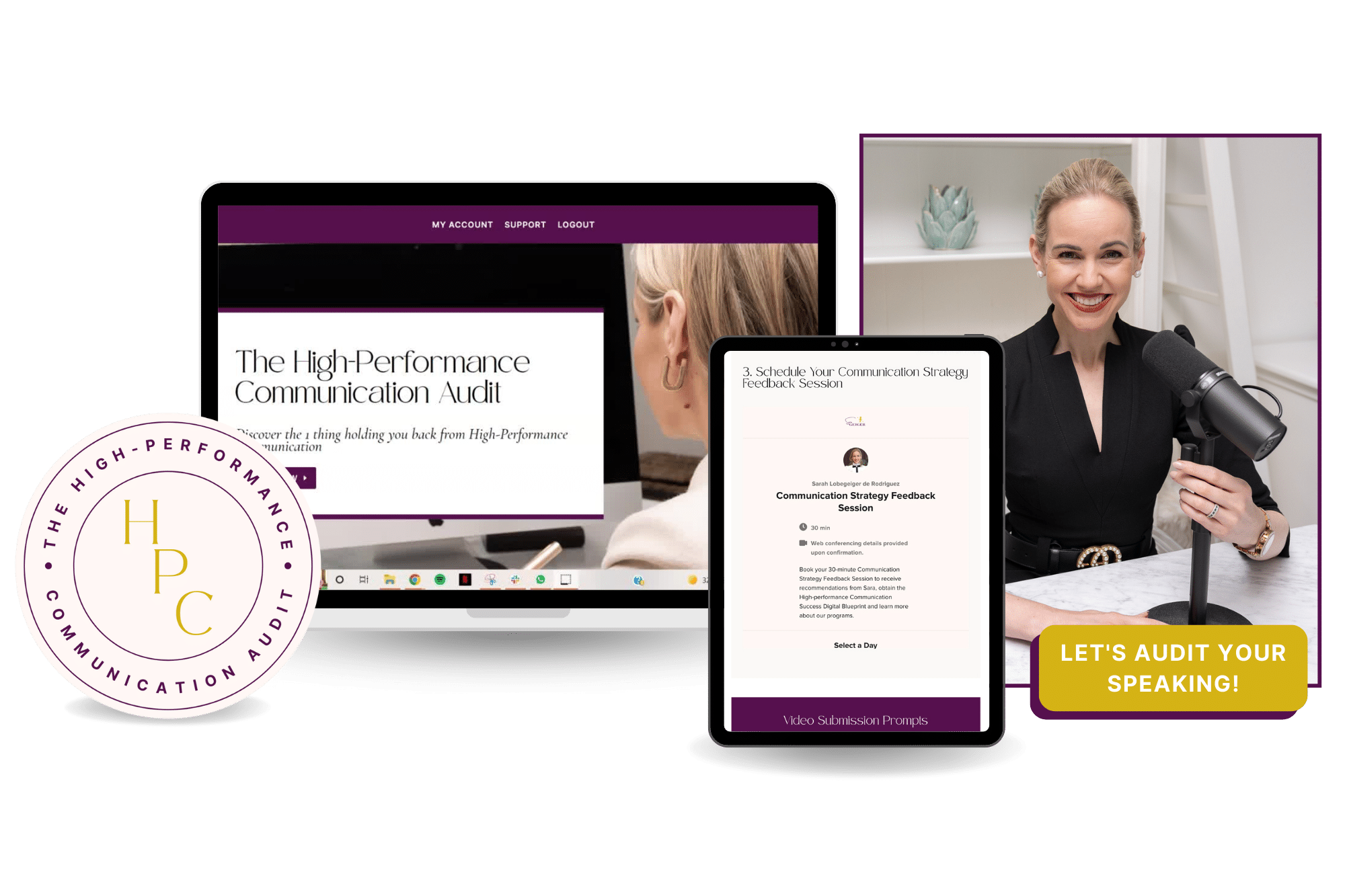Voice Tone Tips
How to Secure a Crystal Clear Voice Tone that Never Fails You
(Even when you’re nervous)
Learn important principles to assist you in achieving an improved and clear voice tone so you can communicate confidently at work.

Have you ever wanted complete control over your voice no matter how anxious, nervous or tired you feel? Today I want to lend a hand and share important principles to assist you in achieving an improved voice tone at work because when our sound slips, it’s easy to experience a loss of confidence mid-conversation.
I’m Sarah Lobegeiger de Rodriguez, an executive speaking consultant, opera singer, and speech therapist with voice therapy expertise.
For the past 20 years, I’ve been working on my own speaking and singing voice and helping 1000s of other people to increase their vocal control and confidence using both performance and voice therapy methods. So let’s get started!
What you’ll discover about clear voice tone
Today I’m going to spell out voice tone precepts so you can differentiate between using a healthy, impactful tone at work and an unhealthy, subpar sound at work.
You can also find a vlog episode on this page that expands the topic further, so check that out too.
As with all my content on this site, I’ll share more than my opinion. Communication science research extensively validates the connection between tone of voice and career communication outcomes, so I’ll be diligent in sharing the main things you need to know if you’re on a mission to step up your professional interactions and relationships by tweaking your tone.
This blog post is best digested in 3 parts:
- Check the niche voice tone tips below
- Watch the vlog for more detailed training
- Take my free Masterclass, How to Look, Sound & Feel more confident at Work (without having to guess what it takes).
The hard truth about voice tone
I always like to tell my executive-speaking clients that there are two ways to use your voice: the right way, and the wrong way.
As simple as that.
If you’re worrying about which group you belong to, one of the best ways to determine whether your voice is working well is to consider vocal tone consistency.
Clear voice tone vs unhealthy voice tone
Mastery of optimal voice comes down to clear voice tone consistency.
Vocally skilled speakers can speak with a consistently clear sound in all environments, no matter their mood or comfort level, with all contacts in all scenarios. The voice is a muscle, and as with sports performance (like perfecting your golf swing), effective voice use is just as concrete as a hole in one, and not usually the result of trial and error but the outcome of skill, practice and dedication to your technique.
Advanced communicators have dependable voices, no matter how nervous or anxious they feel. And that’s what sets apart a professional singer, actor, captivating team leader or elite public speaker from the general public. Despite nerves, they sound ship-shape.
Vocal consistency is not something you can hope for; it’s something you need to work for, like any skill.
Optimal voice tone is a trainable skill, and if you’d like to gain more vocal clout, clarity and charisma but you’re struggling to identify how to get your voice working, there are many tools available that can help you that will improve how you sound when speaking. And the best approach to take is a science-backed approach with some performance strategies applied for flavour and charisma.
How can we define voice tone?
If you’re not a musician, physicist, recording tone master, singer, actor or voice therapist, it can be incredibly challenging to describe your voice tone in terms of the science and theories behind acoustics and voice production. Of course, vibrational frequencies are at play, but let’s not make this blog post a physics lesson by explaining refractions, tube resonance, filtering, noise and harmonics and formants. Instead, I’ll share the vitals to build your voice knowledge fast!
There are three core voice tone examples that you’ll want to understand when it comes to speaking voice tone.
🚨 Watch the vlog episode to hear some sound samples.

Nasalised voice tone
Nasal voices sound like they do because the bulk of the sound wave passes through the nose rather than being directed to the room via the mouth.
Several studies propose that a nasal voice tone reduces speaker likeability (Zuta, 2007; Petlyuchenko & Chernyakova, 2019), persuasiveness in Australian speakers (Pittam, 1990), and even nasalised laughter comes across as contrived (Pinheiro et al., 2021).
If you want to sound less nasal, assessing your voice is the first step. Our High-Performance Communication Audit includes a voice screener alongside an all out audit of your professional communication.
Croaky or Rough Voice Tone (Pharyngeal Resonance)
A croaky and rough voice is a big red flag for incorrect voice production or damage.
A rough sound occurs when the bulk of the sound gets caught in the back of the throat, usually due to excessively tense vocal muscles.
Pharyngeal resonance is the clinical term for this.
Pharyngeal voice tone is not only very bad for the health and integrity of the muscle, but it can create a vicious circuit. This vocal position increases muscle inflammation and can lead to a voice disorder in many cases. Moreover, besides the medical risks, pharyngeal tone plummets executive presence, credibility and charisma. I hate to break it to you, but the research indicates that speakers prefer “smooth, acoustically brilliant speakers. (Barkat-Defradas, 2021)” and align clear voice tone with increased persuasiveness, reduced social desirability, and even less speaking competence.
A hoarse, croaky and rough speaking voice is a suboptimal sound that will impact professional impression management and how your listeners judge your message.
To solve this, you’ll need to learn to calibrate your voice muscle more effectively when speaking. Voice tone training will deal with how to sequence physical body maneuvers in the voice muscles and lungs to form smooth air pressure levels and muscle symmetry and achieve a polished sound.
If your voice gets stuck in your throat, you can intercept the negative tone circuit and rewire vocal habits through voice therapy exercises.
Sometimes the voice tone deteriorates due to physical misuse, and in other cases, the catalyst is performance pressure.
Speaking anxiety factors can be fixed with communication tools that aid self-regulation, message preparation strategies, and voice tone training to prevent emotions from hijacking a clean and clear sound.
Clear Voice Tone (Oral/Modal Resonance)
There are many prospects for speakers to enhance their voice production; the best outcome to aim for is a clear voice tone. The clinical term for this is oral/modal resonance.
Optimal voice tone production occurs when the bulk of the sound wave is directed forward into the room via the mouth cavity without minimal rerouting through the nose (creating a nasalised sound) or entrapment at the back of the throat (resulting in a croaky or creaky sound).
Good voice use results in a projectable, clear sound and the outcome of correct muscle positioning, ease and air pressure flow, posture and speech timing.
Clear voice tone is not just physical; it’s behavioural.
Communication pressure always disrupts a speaker’s voice when voice preparation skills are absent.
Since vocal consistency tends to drop in communication risk zones, let’s explore some interactional booby traps that will derail a clear voice tone and speaking confidence at work.
Voice Tone Skill Barrier #1: Weak Sentence Intonation skills
Many speakers need to learn how to achieve a consistent, clear tone across phrases, between clauses or sentence endings.
How to fix this:
- Voice intonation techniques will train you to suspend a sentence and message to maintain expressive intent until the last word without a vocal cutout.
- Vocal Breath management drills will also assist in building up build stamina to sustain even airflow until the very last word to maintain a smooth sound.
Voice Tone Skill Barrier #2: Performance pressure when Self Advocating or being Assertive
Most of my clients have goals around increasing their comfort levels when setting barriers, getting through difficult conversations and being assertive at work.
In these settings, it’s normal for voice tone to slip in untrained speakers when faced with conflict risks.
In this case, voice tone becomes a secondary goal because it will be hard to secure voice clarity if the structure of what you’re saying is haywire.
How to fix this:
Social intelligence training for high-risk contexts like assertive interactions can prepare your message so that your ideas flow seamlessly and rapport stays intact. The C-Suite program for Emerging Leaders assists career professionals to use proven logic templates to guide dicey interactions.
You may find that if your voice is breaking down in isolated conversational contexts or with certain types of conversation partners, but in place when you feel at ease and socially comfortable, you’re dealing with social intelligence goals more than voice tone goals.
Voice Tone Skill Barrier #3: Cognitive overload while sharing unformed thoughts
Getting a good sound out while speaking can become haphazard when our thoughts go into overdrive, like when we’re met with unexpected questions for which we need answers or when experiencing communication fatigue.
When the link between your thought – idea processing – speaking is interrupted, your message flow and sound flow lose connection without speech flow techniques.
Cognitive hesitations and logical structure issues in conversations will have an acoustic impact if not managed properly.
Unskilled voice users will sound nervous, anxious and hesitant in this scenario because topic preparation issues lead to voice tone discombobulation.
If difficult questions, complex topics or racing thoughts set off a croaky tone, gasping breath or voice volume difficulties, you’ve found a primary goal for your communication skills growth- logical flow training.
The C-Suite Program dedicates an entire module to training logical plug-and-play structures with tools that strengthen cognitive poise and comfort, even if you’re feeling paralysed bewilderment about how to respond to a work colleague, client or contact.
The outcome?
You’ll garner positive impacts on your professional reputation management and credibility if you integrate the link between the flow of your thoughts. The capacity to overcome physical timing pressures while speaking and sound eloquent will also increase your speaking confidence. And, you’ll also set cognitive sophistication bias in your favour.
Voice Tone Skill Barrier #4: Challenges with Vocal projection
Insufficient speech volume causes message breakdowns.
Firstly, inaudible messages don’t get across acoustically and cognitively because volume enables us to project over noise as much as express the intensity of our message.
Leaders and ambitious career professionals must learn to project their voice with exceptional tone and power.
Did you know that people perceived as more confident in the corporate sector almost indefinitely use a higher voice volume than those seen as less secure? So there is a bias around voice volume. Speak too softly; chances are, your ideas will land poorly.
Voice tone Skill Barrier #5: How you position your body always has an acoustic impact.
Postural symmetry is a crucial indicator of voice tone success- that’s why opera singers don’t stand like neanderthals on stage! The outlying structures encasing the vocal ligament set up your voice tone.
Neck position, muscle tension levels, alignment and stance, all impact how well you can calibrate your airflow and voice muscle symmetry.
Body positioning alone can make or break your voice tone.
Voice tone Skill Barrier #6: Performance anxiety should be isolated from your voice tone outcomes
So far, you’ve learnt that effective self-regulation can positively impact your vocal consistency, but what can we do about the negative repercussions of performance anxiety?
If your voice clams up on stage, in stand-up meetings or while public speaking, don’t pass it off as performance anxiety. All performers are anxious on stage; the difference between an elite singer or performer and the general public is that they’ve learnt to separate their tone from their stage anxiety.
It took me several years as a young singer to master the fear and performance pressure on stage so that I could regulate my breathing and exhibit advanced elite opera singing skills like high notes, acting and character development and singing in languages other than English in tune and on time. I’m pleased to tell you that you won’t need to do as much work as an opera singer to show up on stage with vocal consistency during public speaking because opera singers are the astrophysicists of the vocal performance world. But some essential strategies to regulate nervous performance anxiety, so your voice tone is secure, will build your confidence on stage.
I strongly encourage you to work on performance anxiety management strategies with someone qualified to assist you with the voice tone needs as much as the artistic and communication science of captivating speaking.

Learn how to warm up your voice, then learn how to use it
Achieving an impeccable voice tone is a double-edged sword because many communication performance pressure factors and technique factors can trip us up.
The first step to achieving a clean, clear voice tone and increasing your consistency while speaking at work is to learn how to warm up your voice and then get some solid training in voice projection, tone, expression, monotone reduction and vocal charisma tactics (lots of research into this area).
Here are some excellent voice skill goals that are waiting for you if you’re hoping to master your voice confidence and charisma
- Build the voice muscle stamina, calibration and symmetry while speaking through voice tone drills to reduce a croaky sound or inconsistent qualities so that you always sound clear no matter whom you’re speaking with and no matter the environment, mood or topic.
- Increase vocal expression if you’re inclined to sound monotone.
- Decrease excessive vocal expression to prevent sounding too strident or incredulous.
- Learn to secure a consistent voice tone from the beginning to the end of sentences to ensure that your message lands firmly.
- Secure your skills when speaking assertively or self-advocating by incorporating validated language template tools that help you set boundaries while building rapport and then how to maintain tone until the end of each statement.
- Modify your voice volume to suit the space in which you speak. You should be able to project your voice sufficiently in a large concert hall full of people without a microphone and also without losing your voice after doing so
- Learn how to warm up your voice daily to build the muscle’s stamina, integrity and coordination as much as breath production consistency.
- Achieve a clear voice tone, no matter your emotional state at work, by obtaining niche communication training that builds your social intelligence and relational agility
- Gain strategies to build solid logical message flow in the heat of the moment so that you can prepare your message smoothly before speaking, reducing the risk of a domino effect on your voice tone
- Learn how to create the best postural support that influences muscle symmetry while speaking on the phone, presenting and sitting at your desk. If you’re compressing access to your breath chamber or experiencing excess musculoskeletal tension in the torso, chest and neck regions, you’ll be unable to maintain tonal consistency.
Optimise your Voice Tone, Boost Your Delivery & Express Yourself Better.
If you want to improve your communication, you need to know this: There are 6 critical bottlenecks that will hold you back from clear and confident communication and speaking with authority & expertise.
You need to learn what your #1 bottleneck is before you can fix it. Solving this problem for clients from all over the world is what I do all day, every day through my modern elocution services…
From the boardroom, to the podium, over the phone, or behind the lens- I’ll meet you at the communication barrier you’re facing and help you to smash it!
I’ve provided speaking assessment and modern elocution training to people from all sorts of professions at different stages in their career path from middle management through to company directors.
Stop feeling second class in the office, because your ideas aren’t.
You just need to learn to speak with authority, vocal charisma & clarity. My tools will show you how.
Did you find this topic helpful? If you want more insight into how your voice tone is working for you structurally, start by taking the following vocal health questionnaire, which well helps you gain a fundamental insight into how reliable your voice is physiologically.

- Barkat-Defradas, M., et al. (2021). Vocal Preferences in Humans: A Systematic Review. Voice Attractiveness: Studies on Sexy, Likable, and Charismatic Speakers. B. Weiss, J. Trouvain, M. Barkat-Defradas and J. J. Ohala. Singapore, Springer Singapore: 55-80.
- Petlyuchenko, N., Chernyakova, V. (2019). Charisma and female expressiveness: Language, ethnoculture, politics, Lege artis. Language yesterday, today, tomorrow 4 (1), 83-132
- Pinheiro, A. P., et al. (2021). “Emotional authenticity modulates affective and social trait inferences from voices.” Philosophical Transactions of the Royal Society B: Biological Sciences 376(1840): 20200402.
- Pittam, J. (1990) The Relationship between Perceived Persuasiveness of Nasality and Source Characteristics for Australian and American Listeners, The Journal of Social Psychology, 130:1, 81-87
Did you enjoy this post? Make sure to subscribe to our YouTube channel to get more content to increase your communication skills!
About the Author
Dr Sarah Lobegeiger de Rodriguez is a Keynote Speaker, Executive Speaking Coach, and Opera Singer who likes to play with words, sounds, and your impact.
Her academic background is in Music Performance, Communication Science and Speech & Language Pathology. She assists executive communication clients all over the world as a communication consultant with strong expertise in CEO, Founder and Entrepreneur communication strategies.
Connect with Sarah on LinkedIn.





